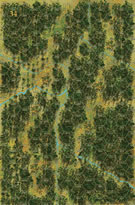| Author |
dricher
|
| Method |
Solo |
| Victor |
Japan |
| Play Date |
2014-12-10 |
| Language |
English |
| Scenario |
KoTr008
|
In this scenario the Australians are defending the six villages on the map (start with five, and one in no man’s land), while the Japanese must take villages. Points are awarded for villages controlled (3) and enemy steps inflicted (1).
While the Japanese enter the map, the Australians immediately occupy Missima, the northern-most village on their right flank. The Japanese are getting in their own way trying to get on the map, and entry is slow. They divide, with a larger contingent going against Missima, and the smaller contingent going towards Isurava (northern-most on the left). The Japanese quickly assault Missima, and start out poorly. Australian troops line the trail most of the way back to Asigara, and the Japanese attempt to flank, and launch assaults up the length of the trail, sending a small force to try and get behind Isuarava.
The Isurava force moves slow, fearing hidden Australians units. Eventually they spot the hidden units (and waste some firepower), but hesitate to rush Isurava due to firing lanes. Mortars perform poorly, but cause just enough disruption in combo with direct fire to allow the Japanese charge. While the Missima force holds well, a heavy exchange of casualties outside and in Isurava favors the Japanese, and on turn 18 they finally take the village. Australian reinforcements near the Rest House exact a heavy toll on the Japanese occupiers, blasting multiple steps and sowing discord over a couple turns until the Japanese can finally threaten their flanks and force a withdrawal to the Rest House.
Missima falls on turn 19 (finally!), and the Japanese push on to Asigara. A wickedly successful assault on Asigara blows the defending Aussies away, and on turn 22 Asigara belongs to the Japanese. Exhaustion and low ammo causes the Japanese to halt their advance, and the Australians hunker down in the last three villages. Three villages to both sides, but due to Australian losses the final score is Japanese 38, Australians 19.
I rated this a 3. The action was great, I enjoyed the scenario, and the geographical goals worked very nice. However, the 7/6 morale of most of the Australian troops is devastating. The Japanese just rolled through Australian troops, and stacked up a huge body count. From a pure geographical objective standpoint it is an excellent scenario, but the step count objective really slants this in favor of the Japanese. A strong 3, but I’d hate to be Australian in a head to head.
|






 KoTr007
KoTr007 

















